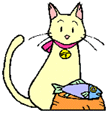Add Your Heading Text Here
Table of Contents
Assist Feeding – How Much to Syringe Feed
Feline Nutrition – Canned vs. Dry… Summary
Pro-Active Cat Care – Reading The Signs
Feline Obesity – Dining Alone Tonight?
Assist Feeding – How Much to Syringe Feed
by Kathy Fatheree
Every cat is different with how much food they will accept in one feeding.
Every cat is different with how much food they need to maintain or gain weight.
A severe hardship and stressful situation occurs when you cannot get enough food into your cat to prevent weight loss. This is tough for me to say, but if you cannot get the right amount of food into your cat each and every day… your cat will slowly starve. I start to cry just writing that…
Here are some ideas to help you and your kitty with syringe feeding the proper amount:
- Ask your vet how much you need to feed your cat each day. Your cat may not accept the full amount at first, especially if your cat has not been eating for quite a while, so allow your cat to work up the the required amount over 5 days to a week… no longer.
- Create a chart and write down exactly how much your cat eats at each feeding and the time of the feeding. Add up the total amount eaten at the end of the day to know if you are meeting the goal or need to try to feed more.
- Ask your vet, a vet technician or an understanding but strict friend to require you to report your daily feeding amounts. Syringe feeding can be stressful and you may try and try, but never be able to feed enough. If this is true for you, your vet will need to intervene and come up with a solution.
- Ask for help. If you are having trouble, ask your veterinarian for help, pay a vet tech to come to your house everyday to help with at least one feeding, ask around to find a friend or friend-of-a-friend to come over everyday to help you out (you’ll be surprised at the number of cat lovers once you start asking around), and certainly write to the great people on the Yahoo Assisted Feeding list for help and advice… you are not alone.
On the Net:
Here’s a website that has a calculator to give you a ball park on how much to feed. Remember, use a postal scale, baby scale or other scale that weighs to the ounce as your best guide for weight loss/gain.
Feline Nutrition – Canned Food vs. Dry Food… Summary
by Garry White
Before we proceed: Please keep in mind that I’m neither a nutritionalist nor a professional research scientist. With that awareness, I tried to maintain an unbiased view by gathering data from a variety of sources throughout the pet-food, veterinary, and vet-education communities. However, while the information I’ve collected is extensive, it is not a to be construed as comprehensive or complete; there are endless avenues that could yet be pursued.
Well, here we are. I’ve presented what I feel is reasonable information about some of the whys and why-nots for both canned cat food and dry cat food diets, and the bottom line is about as firm as wet sock; there are reasons why we should (and should not) consider either one. Plenty of scientific evidence to support you on either side of the fence, so the issue of which diet we select for our cat seems to be one of preference. Those of you who are in favor of a specific feeding protocol certainly are encouraged to challenge my – or anyone’s- conclusion; that’s how good things become better things. I’ll gladly research any practical train of thought, conventional or otherwise, and we’ll report on that as well. So far, I’ve been wishy-washy about taking a stand on this touchy issue, but believe it or not, I finally have! Can you guess what it is?
Read my Canned Cat Food versus Dry Cat Food Summary.
ProActive Cat Care – Reading The Signs
by Garry White
I lived for many years in a summer-resort area in the northern Adirondack Mountains. Sensibly, most of the places closed down during the winter months, and each winter we got to make fun of this particular sign:

Signs can often be conflicting, confusing, and even misleading. As for the all-season motel being closed for the season, well, the worst thing that sign might generate is a chuckle or two. But there are many instances when failing to read signs can have a far greater impact. For example: You could be paying way too much for good Scotch, when just down the aisle it’s on sale!
Obviously you know I’m talking about kitty signs, not booze or motels, and this week we’re going to get specific about a horrible disease that claims more cats than any other: Feline kidney failure, known as Chronic Renal Failure, or CRF. Those three tiny letters have struck terror and dread in the hearts of countless people for decades, and the disease itself has caused more suffering than we could ever know. Not many years ago, CRF was a death sentence, period. But not anymore; there have been many wonderful, life-saving advancements in treating CRF and, inarguably, the key to successful treatment is early diagnosis. We can catch this ugly, devilish monster known as CRF in its infancy, but it’s up to us…Dr. Mom and Dr. Dad. Please read on…
I dare you to CLICK HERE to learn more…
Feline Obesity – Dining Alone Tonight?
by Kathy Fatheree
So what if you have a multi-cat household with skinny kitties and fat kitties? How do you keep the fat cats on a diet? It can certainly be a challenge!
One solution is a 2-part solution:
- #1 Meal Feed. Convert all of your cats from grazers to eating meals 2 or 3 times a day. For example, feed them in the morning and allow them to eat all they want for 30-minutes to an hour, then take the food up. Then feed them again in the evening the same way. If you work at home, you may need to have a lunch time feeding until they are truly accustomed to meal feeding.
- #2 Fat Cats Dine Alone. Once your cats are used to meal feeding, it’s time to start controlling the portions. Separate your fat cats into separate rooms and feed them their food. Hopefully by now, they will eat all of their food in 20 minutes or so. At first, your cats may be confused when they are put into a room all alone and may not eat because they are scared… perhaps even thinking that they are being punished. Spending time alone with each cat and praising the cat will encourage eating. Be patient and pour out the love and your cats will become accustomed to eating by themselves.
This is a “for sure” way of being able to control the portions which will help your cat lose weight.
NOTE: Elimination immediately after eating is a normal physiological process. If you have to leave your cats separated for more than 20 minutes or so, put a litter box in each cat’s feeding room… away from the door and the food. “Holding it” can be very uncomfortable and you will want to protect your cat from any negative association with eating alone/elimination woes, not to mention the trauma of having an accident.
Disclaimer: Kathy Fatheree is not at all a medical expert. Contents of this web site are a collection of Kathy’s assist feeding experiences as well as the experiences of other cat owners who have assist fed their cats. While every effort has been made to ensure the accuracy of the information, Kathy Fatheree or anyone associated with this web site cannot be held responsible for anything that may happen as a result of using the information on this site.
